Janome 4800 User Manual

INSTRUCTION BOOK
TABLE OF CONTENTS
SECTION I NAMES OF PARTS |
SECTION III BASIC SEWING |
Name of Parts ............................................................. |
3 |
|
Screen Sharpness Adjusting Dial ............................... |
4 |
|
Extension Table........................................................... |
4 |
|
Standard Accessories ................................................. |
5 |
|
SECTION II GETTING READY TO SEW |
|
|
Connecting Machine to Power Supply ........................ |
6 |
|
For Your Safety ........................................................... |
6 |
|
Controlling Sewing Speed ........................................... |
6 |
|
Main Function of Buttons/Keys ................................... |
7 |
|
Up/down needle position button ........................ |
7 |
|
|
Auto-lock button ............................................. |
7 |
|
Reverse button ............................................... |
7 |
|
Mode selection key ......................................... |
8 |
|
Twin needle key .............................................. |
8 |
|
Editing key ...................................................... |
8 |
Stitch width selection key ............................... |
8 |
|
Stitch length selection key .............................. |
8 |
|
|
Message key .................................................. |
9 |
|
Turn-over memory key ................................... |
9 |
|
Elongation key ................................................ |
9 |
|
Stock/call key ................................................. |
9 |
|
Clear key ...................................................... |
10 |
|
Memory key .................................................. |
10 |
Direct pattern selection and number keys ... |
10 |
|
Pattern selection and screen indication ....... |
11 |
|
|
Number key selection................................... |
11 |
Memory Mode/Buzzer Sound/Multiple |
|
|
Language Settings .................................................... |
12 |
|
To Raise or Drop the Feed Dogs .............................. |
13 |
|
Pressure Dial ............................................................. |
13 |
|
Presser Foot Lifter .................................................... |
13 |
|
Changing Needles ..................................................... |
14 |
|
To Attach and Remove the Presser Foot .................. |
14 |
|
To Remove and Attach the Foot Holder ................... |
14 |
|
Selecting Needle and Thread ................................... |
15 |
|
Winding the Bobbin................................................... |
16 |
|
|
Set the spool ................................................... |
16 |
|
Removing the bobbin ................................... |
16 |
|
Winding the bobbin ...................................... |
17 |
|
Inserting the bobbin...................................... |
18 |
|
Threading the Machine................................. |
19 |
|
Threading the machine ................................ |
19 |
|
Needle threader ............................................ |
20 |
Drawing up the bobbin thread ...................... |
21 |
|
|
Balanced Thread Tension ............................. |
22 |
|
Auto-thread tension ...................................... |
22 |
Manual thread tension adjustment ............................ |
22 |
|
Straight Stitch Sewing ............................................... |
23 |
|
|
Starting to sew ................................................ |
23 |
|
Changing sewing direction ........................... |
23 |
|
Finishing sewing .......................................... |
23 |
Practice Common Stitching Skills ............................ |
24 |
|
Using the Seam Guides on the Needle Plate ........... |
24 |
|
Turning Square Corners ............................................ |
24 |
|
Using the Quilting Bar ............................................... |
24 |
|
Sewing on Heavy Fabrics ......................................... |
24 |
|
|
Manual stitch length ........................................ |
25 |
|
Variable needle position ............................... |
25 |
Various Utility Stitch .................................................. |
26 |
|
|
Basting ............................................................ |
26 |
|
Straight stitches ............................................ |
27 |
|
Automatic reverse stitch ............................... |
27 |
|
Triple stretch stitch ....................................... |
27 |
|
Auto-lock stitch ............................................. |
27 |
|
Stretch stitch ................................................. |
28 |
|
Saddle stitch ................................................. |
28 |
|
Sculpture stitch ............................................. |
28 |
Zigzag Stitch ............................................................. |
29 |
|
|
Interfacing ....................................................... |
29 |
To change the width and length ................... |
29 |
|
Variation of Zigzag Stitches ...................................... |
30 |
|
|
Overcasting ..................................................... |
30 |
|
Tricot stitch ................................................... |
30 |
|
Knit stitch ...................................................... |
31 |
|
Overedge sewing (1) .................................... |
31 |
SECTION IV DECORATIVE STITCHING |
|
|
|
TECHNIQUES |
|
Overedge Sewing (2), (3) ......................................... |
32 |
|
Sewing Buttons ......................................................... |
33 |
|
Sensor Buttonhole................................................ |
34-37 |
|
|
Automatic buttonholing ................................... |
34 |
|
Sewing preparation ...................................... |
35 |
|
Starting sewing ............................................. |
36 |
Adjusting Stitch Width and Density in Buttonholes .. 37 |
||
Sensor buttonhole 09 and 10 .......................... |
38 |
|
Adjusting the stitch width and
density in buttonholes 09 and 10 ........................... |
38 |
Corded Buttonholes .................................................. |
39 |
Free Size Automatic Buttonhole 20 .......................... |
40 |
Zipper Sewing ........................................................... |
41 |
Put in a zipper ................................................. |
41 |
Attaching the zipper foot .............................. |
41 |
Fabric preparation ........................................ |
41 |
To sew ....................................................................... |
41 |
1
Zipper Sewing, contÕd ............................................. |
42 |
Darning ..................................................................... |
43 |
To sew .................................................................. |
43 |
For darning less than 2 cm ............................... |
43 |
To memorize darning stitches ........................... |
43 |
Adjusting the shape of darning stitches ............ |
43 |
Bartacking ................................................................. |
44 |
Memorizing bartacking ........................................ |
44 |
Adjusting the evenness of bartacking stitches . 44 |
|
Rolled Hem ............................................................... |
45 |
Blind Stitch Hemming ............................................... |
46 |
How to fold the fabric ........................................... |
46 |
How to sew ....................................................... |
46 |
Changing the needle position ........................... |
46 |
Pintucking ................................................................. |
47 |
Quilting ..................................................................... |
47 |
Shell Tack ................................................................. |
48 |
Applique .................................................................... |
48 |
Smocking .................................................................. |
49 |
Fagoting .................................................................... |
49 |
Scallop Stitch (A), (B) ............................................... |
50 |
Patchwork ................................................................. |
51 |
Satin Stitch Sewing .................................................. |
51 |
Cross Stitch .............................................................. |
52 |
Decorative Stitch ...................................................... |
52 |
Cording ..................................................................... |
53 |
Twin Needle Stitching ............................................... |
54 |
Adjusting Pattern Balance ........................................ |
55 |
Adjusting distorted stretch stitch patterns ............ |
55 |
Adjusting distorted letters or numbers in |
|
B or C Mode ......................................................... |
55 |
Adjusting the stitch density for buttonhole 20 ...... |
55 |
Programming Decorative Stitch Patterns 61, 58 ...... |
56 |
A programmed stitch sewing pattern finishing with . |
|
auto-lock, stitches 61, 58, 98 ............................... |
56 |
Cycle Stitching with Mirror Image Patterns .............. |
57 |
Restarting Programmed Patterns ............................. |
57 |
Elongation ................................................................. |
58 |
Sewing sample, stitch pattern 51 ......................... |
58 |
Sewing Letters in Block Style ................................... |
59 |
Combining Letters in Script Style ............................. |
60 |
Editing Function (1) .................................................. |
61 |
Check and correct pattern combination |
|
before sewing ....................................................... |
61 |
Deleting a stitch pattern, letter or |
|
number by editing ................................................ |
61 |
Adding letters or space between letters ............... |
62 |
Editing Function (2) .................................................. |
63 |
Uniform width, length adjustment ........................ |
63 |
Editing Function (3) .................................................. |
63 |
Custom stitch sizing ............................................. |
63 |
SECTION V CARE OF YOUR MACHINE |
|
Care of Your Machine ............................................... |
64 |
Cleaning the Hook Race and Feed Dogs ................. |
64 |
Replacing the Bobbin Holder .................................... |
64 |
Replacing the Light Bulb ........................................... |
65 |
Removing light bulb ............................................. |
65 |
Attaching light bulb ........................................... |
65 |
Troubleshooting .................................................. |
66, 67 |
When message appears on the screen ............... |
67 |
2
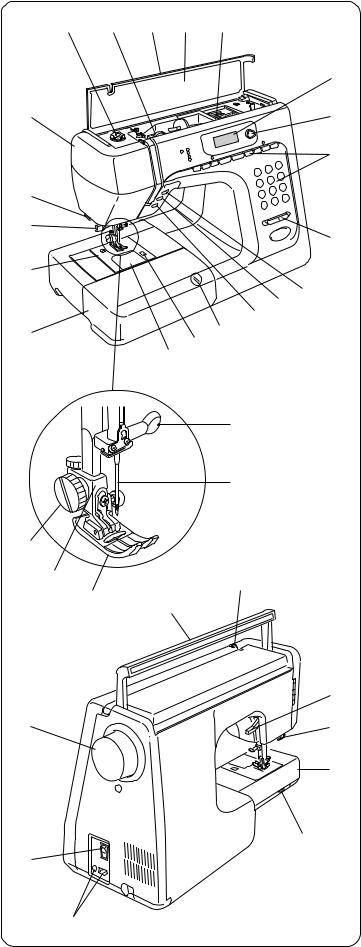
|
|
|
|
|
|
SECTION I NAME OF PARTS |
5 |
4 |
3 |
2 |
1 |
Names of Parts |
|
|
|
|||||
|
|
|
|
|
1 |
Foot storage compartment |
|
|
|
|
20 |
2 |
Flip-top sewing instruction panel |
|
|
|
|
|
3 |
Top cover |
6 |
|
|
|
19 |
4 |
Auto-tension dial |
|
|
|
|
18 |
5 |
Pressure dial |
|
|
|
|
6 |
Face plate |
|
|
|
|
|
|
||
7 |
|
|
|
|
7 |
Thread cutter |
8 |
|
|
|
|
8 |
Needle threader |
|
|
|
17 |
9 |
Needle plate |
|
|
|
|
|
|||
9 |
|
|
|
|
10 |
Extension table |
|
|
|
|
11 |
Hook cover plate |
|
|
|
|
|
15 16 |
||
|
|
|
|
12 |
Hook cover plate release button |
|
|
|
|
|
14 |
||
|
|
|
|
|
|
|
10 |
|
|
|
13 |
13 |
Feed balancing dial |
|
|
|
11 |
12 |
14 |
Reverse button |
|
|
|
|
|||
|
|
|
|
|
15 |
Auto-lock button |
|
|
|
|
|
16 |
Up/down needle button |
|
|
|
|
21 |
17 |
Speed setting lever |
|
|
|
|
|
||
|
|
|
|
|
18 |
Keyboard |
|
|
|
|
22 |
19 |
Screen sharpness adjustment dial |
|
|
|
|
|
20 |
LCD screen |
|
|
|
|
|
21 |
Needle clamp |
25 |
|
|
|
|
22 |
Needle |
24 |
|
|
|
26 |
23 |
Presser foot |
|
23 |
|
|
24 |
Foot holder |
|
|
|
77 |
|
|||
|
|
|
|
25 |
Thumb screw |
|
|
|
|
|
|
||
|
|
|
|
|
26 |
Thread take-up lever |
|
|
|
|
|
27 |
Carrying handle |
|
|
|
|
34 |
28 |
Handwheel |
28 |
|
|
|
33 |
29 |
Power switch |
|
|
|
30 |
Machine sockets |
||
|
|
|
|
|
||
|
|
|
|
32 |
31 |
Drop feed lever |
|
|
|
|
|
32 |
Free arm |
|
|
|
|
|
33 |
Buttonhole lever |
|
|
|
|
31 |
34 |
Presser foot lifter |
29 |
|
|
|
|
|
|
30
3

Screen Sharpness Adjusting Dial
Use this to adjust the sharpness of the liquid crystal display.
If no indication is shown on the screen after you switch on the power, adjust the screen brightness with this dial.
Extension Table
The extension table provides added sewing surface and can be easily removed for free arm sewing.
Detaching the table:
Pull the table away from the machine, as illustrated.
Free arm sewing
Free arm sewing is useful for darning socks or mending knees, elbows or areas of wear in children’s cloths.
Attaching the table:
Push the extension table until it snaps into the machine.
1 |
2 |
1 |
Projection |
|
|
||
|
|
2 |
Hole |
4
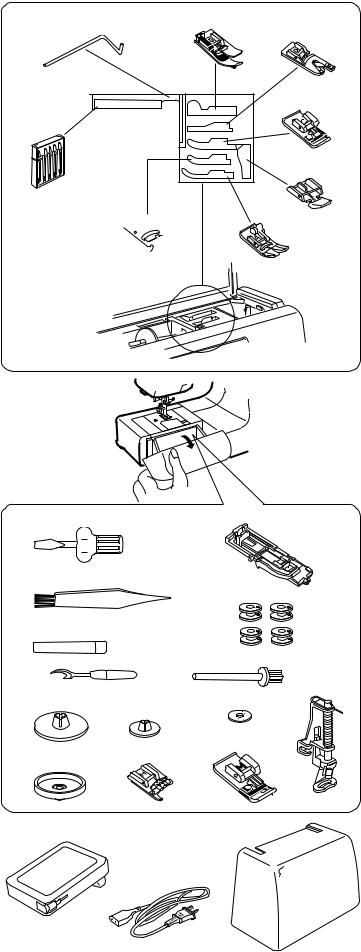
2 |
3 |
4 |
L |
G |
|
5 |
|
|
||
1 |
D |
|
|
C |
|
|
|
|
|
|
|
|
F |
|
|
|
A |
E |
6 |
|
|
||
|
|
|

 7 8
7 8 
Standard Accessories
1Set of needles
2L: Quilting bar
3G: Blind hem foot
4D: Hemmer foot
5C: Overedge foot
6E: Zipper foot
7A: Zigzag foot
*It is attached on the machine.
8F: Satin stitch foot
9 |
|
10 |
|
o |
Screwdriver |
|
|
!0 |
R: Automatic buttonhole foot |
||
|
|
|
|
||
|
|
|
|
!1 |
Lint brush |
11 |
|
|
|
!2 |
Bobbins |
|
|
12 |
|
!3 |
Seam ripper |
|
|
|
!4 |
Spool holder (Large) |
|
13 |
|
|
|
||
|
|
|
|
* It is attached on the machine. |
|
|
|
16 |
|
|
|
|
|
|
!5 |
Spool holder (Small) |
|
|
|
|
|
!6 |
Additional spool pin |
14 |
15 |
17 |
21 |
!7 |
Felt |
|
|
!8 |
Spool base |
||
|
|
|
|
||
18 |
19 |
20 |
|
!9 |
H: Cording foot |
|
20 |
M: Overcasting foot |
|||
|
|
|
|
||
|
|
|
|
21 |
P: Basting foot |
22 |
|
24 |
|
|
|
|
|
|
22 |
Foot control |
|
|
|
|
|
||
|
|
23 |
|
23 |
Power supply cord |
|
|
|
|
24 |
Carrying case |
5
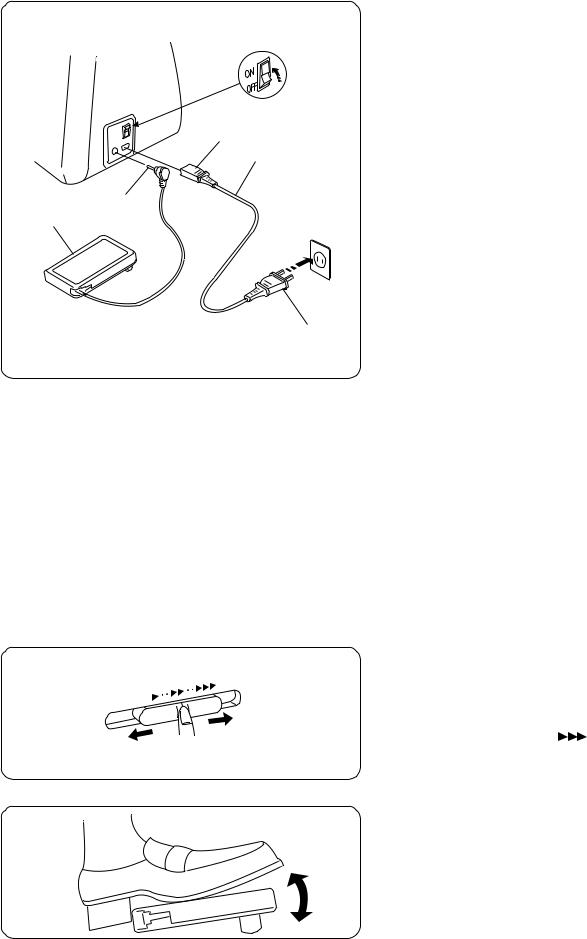
4
2
5
1
6
SECTION II GETTING READY TO SEW
Connecting Machine to Power Supply
Before connecting the power supply, make sure the voltage and frequency shown on the machine conform to your electrical power.
Turn off the power switch, and insert the foot control plug 1, machine plug 2, into the machine and power supply plug 3 into the outlet in the following order.
1 Foot control plug
2 Machine plug
3 Power supply plug
4 Power switch
5 Power supply cord
6 Foot control
For Your Safety
* While in operation, always keep your eyes on the
|
sewing area. Do not touch any moving parts such as |
||
3 |
the thread take-up lever, handwheel or needle. |
||
* Always turn off the power switch and unplug from the |
|||
|
|||
|
power supply: |
|
|
|
- When leaving the machine unattended |
||
|
- When attaching or removing parts |
||
|
- When cleaning the machine |
|
|
|
* Do not place anything on the foot control, when not |
||
|
sewing. |
|
|
|
Operating instructions |
|
|
|
For appliances with a polarized plug (one blade wider than |
||
|
the other), to reduce the risk of electric shock, this plug is |
||
|
intended to fit in a polarized outlet only one way. If it does |
||
|
not fit fully in the outlet, reverse the plug. If it still does not |
||
|
fit, contact a qualified electrician to install the proper |
||
|
outlet. Do not modify the plug in any way. |
||
|
Foot controller Model 21371 for use with Sewing Machine |
||
|
MC4800. |
|
|
|
Controlling Sewing Speed |
|
|
|
Speed setting lever |
|
|
|
The maximum sewing speed can be controlled by the |
||
|
speed setting lever. To increase the speed, slide the |
||
|
lever to the right (toward “ |
“). |
|
To decrease the sewing speed, slide the lever to the left (toward “ “).
“).
Foot control
Sewing speed can be varied by the foot control. The harder you press on the control, the faster the machine runs.
Note: The Memory Craft 4800 is equipped with a protective circuit to prevent overheating.
The machine will stop automatically if it is running overloaded for a long time. In such a case, follow the message that appears on the LCD screen.
6
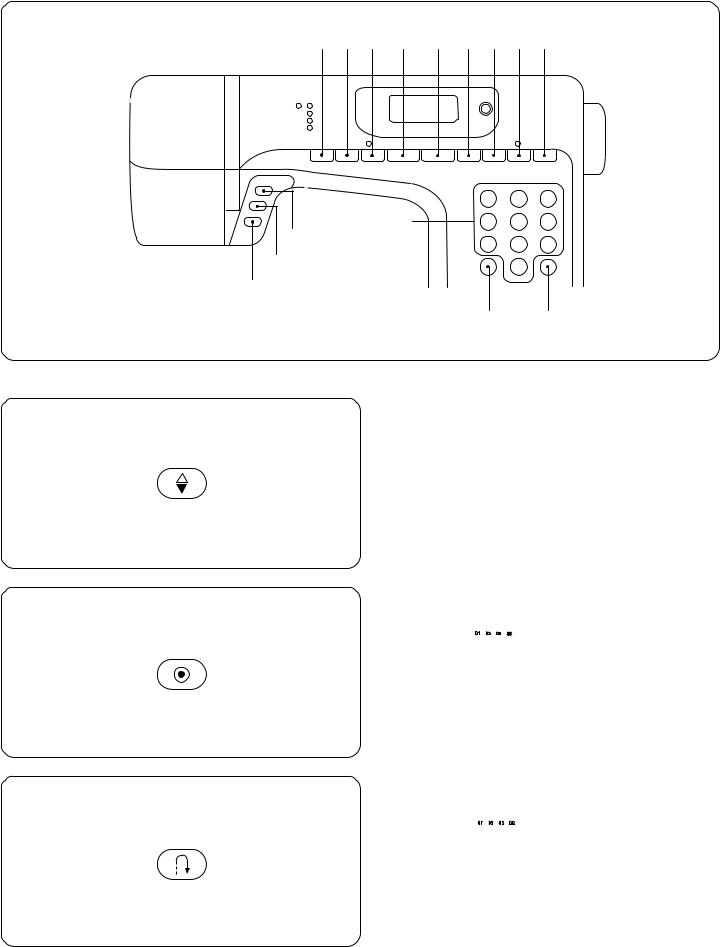
1
2
3
4 5 6 7 8 9 10 11 12
15
1
2
3
14 13
Main Function of Buttons / Keys
• Up/down needle position button
When the Up/down needle position button is pressed, the needle bar goes down and stops in the lowest position. When pressed again, the needle bar goes up and stops in the highest position.
*When this button is pressed, the needle bar alternates between up and down positions when the machine stops.
•Auto-lock button
When stitches 
 are selected, the machine will immediately sew locking stitches when the auto-lock button is pressed, then automatically stop.
are selected, the machine will immediately sew locking stitches when the auto-lock button is pressed, then automatically stop.
When sewing all other stitches, the machine will sew locking stitches at the end of the current pattern and automatically stop.
• Reverse button
When stitches 
 are selected, the machine will sew in reverse while the reverse button is pressed.
are selected, the machine will sew in reverse while the reverse button is pressed.
If you press the reverse button when sewing all other stitches, the machine will immediately sew locking stitches and automatically stop.
7
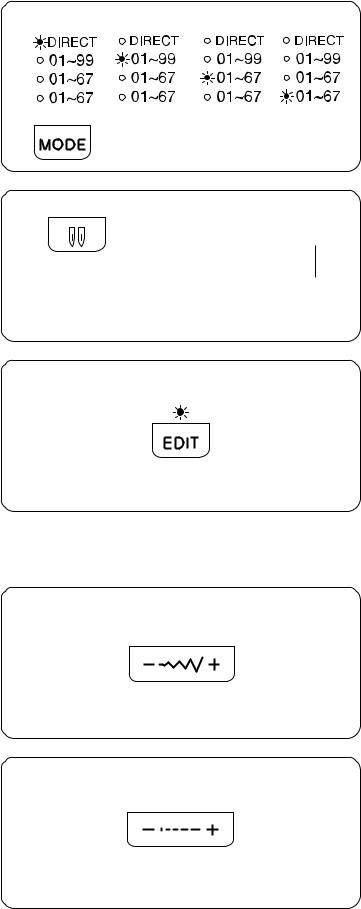
Direct Mode A Mode |
B Mode |
C Mode |
4
5 |
A |
|
6
7
8
• Mode selection key
By pressing the key, LED light will move step by step to select the stitch mode, as shown.
Direct Mode: Direct mode pattern selection
A Mode: |
Pattern selection using number keys utility |
|
and decorative stitches) |
B Mode: |
Character selection using number keys |
|
(block type) |
C Mode: |
Character selection using number keys |
|
(script type) |
• Twin needle key
Just press this button and “A” mark will appear on the display screen.
Press button again for single needle sewing.
• Editing key
This button can be used for adding, deleting and changing combinations and monograms before sewing while programming stitch patterns or monograms.
For editing, use the stitch width “+” or “-” key to select editing position (see page 61, 62).
[Manual setting function of the zigzag width and stitch length for programmed patterns]
The individual programmed zigzag pattern width or stitch length can be changed (see page 63).
• Stitch width selection key
Press “+” or “-” to change the stitch width.
• Stitch length selection key
Press “+” or “-” to change the stitch length.
8
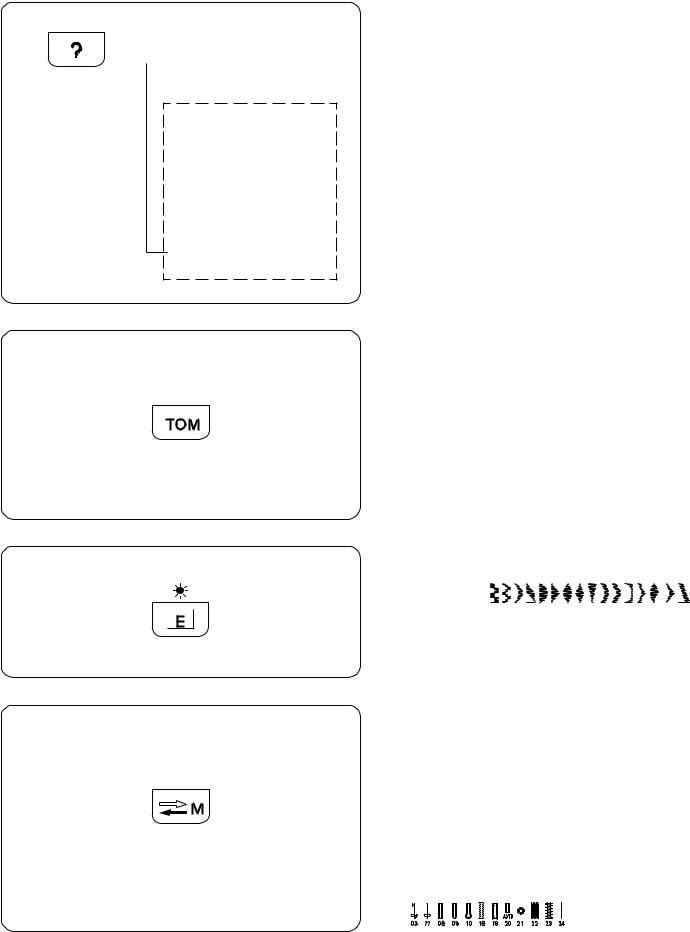
|
• Message key |
|
When Message key is pressed, a detailed message will |
9 |
display suitable stitches, patterns and machine settings. |
|
, |
|
, |
• Turn-over memory key
(To memorize the pattern in mirror image)
Select a desired pattern and press TOM key so the selected pattern’s mirror image will be shown on the
screen.
10
Use this key to memorize and sew patterns in a mirror image. Programmed letters or numbers will be reduced to 2/3 of their actual size when you press the TOM key.
• Elongation key
(For A Mode)
|
Stitches 45 to 60 ( |
) |
! 1 |
can be elongated up to five times their normal length by |
|
|
pressing this key. |
|
|
• Stock/call key |
|
|
When you press the Stock/call key after memorizing a |
|
|
pattern or editing patterns, the currently registered |
|
|
patterns will be deleted and new patterns will be stored. |
|
|
Other than this, you can recall the stored patterns when |
|
! 2 |
you press the Stock/call key. |
|
|
You can store a maximum of 50 programmed patterns |
|
|
and sew. |
|
|
* You cannot store the Direct mode patterns and |
|
|
buttonholes also you cannot memorize |
|
|
( |
) patterns by using |
|
memory key (see page 10). |
|
9
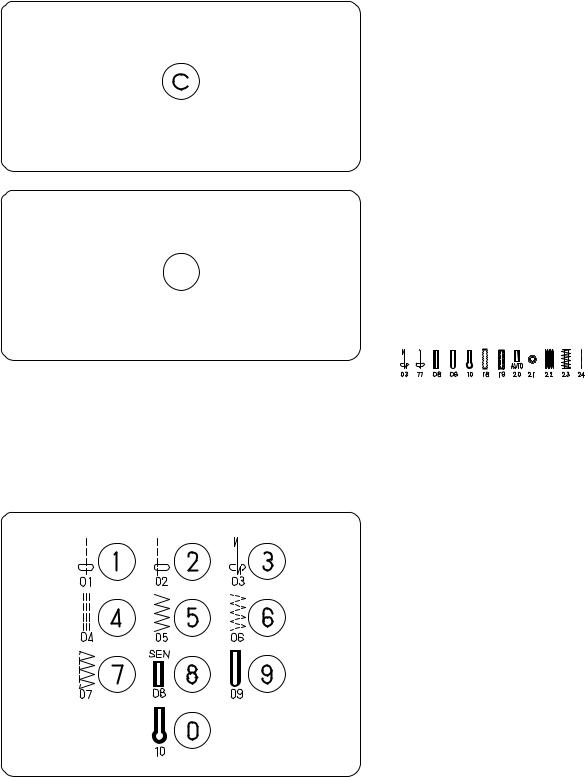
• Clear key
If an incorrect pattern is memorized, pressing this key will immediately clear it (like a backspace key).
13
• Memory key
When this key is pressed after selecting a pattern, the pattern will be memorized as many times as the key is pressed. When the key is pressed after selecting an-
14  other pattern, that pattern will be memorized after the previously memorized pattern.
other pattern, that pattern will be memorized after the previously memorized pattern.
(The maximum number of memory patterns is 50)
* The following patterns cannot be memorized.
* The Direct mode patterns and buttonholes cannot be memorized.
• Direct pattern selection and number keys
15 |
[Direct pattern selection] |
|
You can select the patterns 1 to 10, also buttonhole stitches, square buttonhole to keyhole buttonhole when the mode key is set at the Direct mode.
In A Mode 01~96, the patterns 01 to 10 can be selected by pressing two-digit numbers.
[Number keys]
Press number keys of the pattern number to select the desired pattern.
10
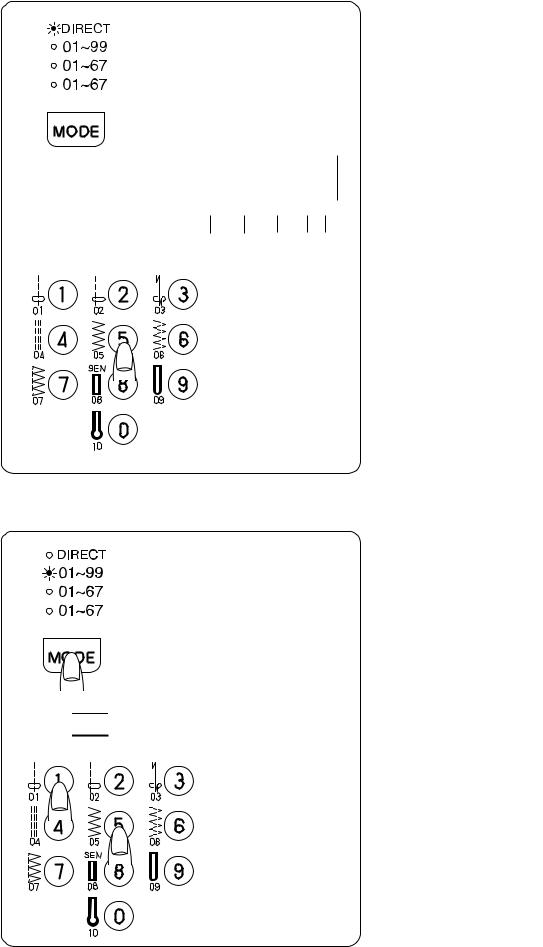
[1]
6
[3]
\
1 2 3 4 5
[2]
• Pattern selection and screen indication
[1]Select the Direct mode pattern selection.
[2]Press the pattern key on the keyboard. Example: Pattern 05, as shown.
[3]The display screens shows from left to right:
1 |
Stitch pattern: |
05 |
2 |
Thread tension: |
AUTO |
3 |
Presser foot: |
A |
4 |
Stitch width: |
5.0 |
5 |
Stitch length: |
2.0 |
6 |
Buzzer sound on: |
|
(see page 12 to mute the buzzer sound)
• Number key selection
You can select the patterns by pressing number keys. Example: pattern number 51
 \
\
11
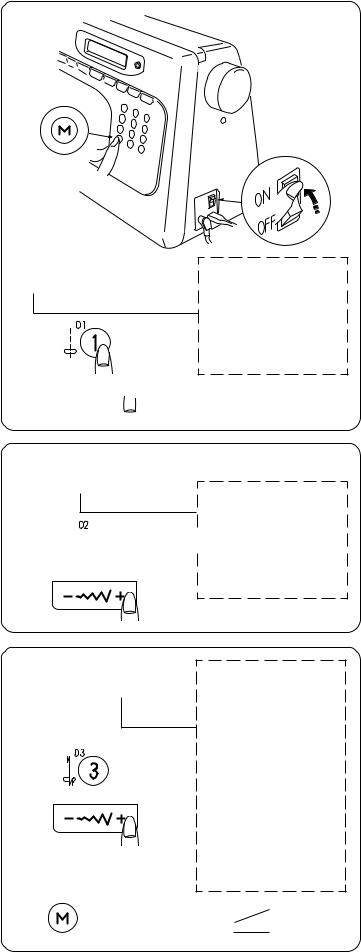
[1]
2
1
\\
[2]
[3] 3
3
4
[1] 

 \\
\\
[2]
5
[2]
[3]
7
[4]
6
Memory Mode/Buzzer Sound/Multiple
Language Settings
NORMAL / RESUMPTION Mode
[1]Turn on the power switch while pressing the memory key.
1 Memory key
2 Power switch
[2]Select “1” on the number key to access the NORMAL/RESUMPTION mode.
You can select the mode by pressing the stitch width
key “+” or “-”.
*NORMAL mode - The last selected pattern setting will not be recalled when you turn on your machine. Machine turns on in straight stitch 01, Direct mode.
*RESUMPTION mode - The last selected pattern setting will always be recalled when you turn on
your machine. Machine turns on in A Mode.
[3]Select the desired mode: NORMAL SET or RESUMPTION SET.
[4]Press the Memory key.
Buzzer
[1]Turn on the power switch while pressing the memory key.
1 Memory key |
2 Power switch |
[2]Select “ 2 “ by pressing the number key to access the Buzzer mode.
You can select the mode by pressing the stitch width “+” or “-”.
[3]Select desired mode “-” SOUND ON or “+” SOUND OFF.
[4]Press the memory key.
*The Buzzer sound setting mark will appear on the screen when you have set it .
Language selection setting
[1]Turn on the power switch while pressing the memory key.
1 Memory key
2 Power switch
[2]Select “ 3 “ by pressing the number key to access language selection settings.
You can select the desired language by pressing stitch width “+” or “-”.
[3]Select the desired language. 3 NORMAL / RESUMPTION
4Buzzer sound “ ON “ or “ OFF”
5Multiple language
[4]Press Memory key.
6NORMAL / RESUMPTION
7Buzzer sound setting mark
12

|
|
To Raise or Drop the Feed Dogs |
|
1 |
|
• For button sewing etc., drop the feed dogs. |
|
|
|
• When finished sewing, raise the feed dogs. |
|
2 |
1 |
The feed dogs must always be up for normal sewing. |
|
2 |
|
1 |
Lowered position |
|
|
2 |
Raised position |
|
|
Pressure Dial |
|
|
|
The pressure dial should be set at “3“ for regular sewing. |
|
|
1 |
Reduce the pressure to “2” for applique, cutwork, drawn |
|
|
work, basting and embroidery. |
||
|
|
||
2 |
|
Set the pressure to “1” when sewing chiffon, lace, |
|
|
|
organdy and other fine fabrics. Velour and knit with a lot |
|
|
|
of stretch may also require a “1” setting. |
|
|
|
Align the number on the dial with the setting mark. |
|
|
|
1 |
Pressure dial |
|
|
2 |
Setting mark |
Presser Foot Lifter
The presser foot lifter raises and lowers your presser
foot.
2
|
|
You can raise it about 0.6 cm (1/4ý) higher than the |
|
|
|
normal up position for easy removal of the presser foot |
|
|
1 |
or to help you place heavy fabric under the foot. |
|
|
1 |
|
|
|
|
|
|
2 |
|
1 |
Normal up position |
|
2 |
Highest position |
|
|
|
||
13
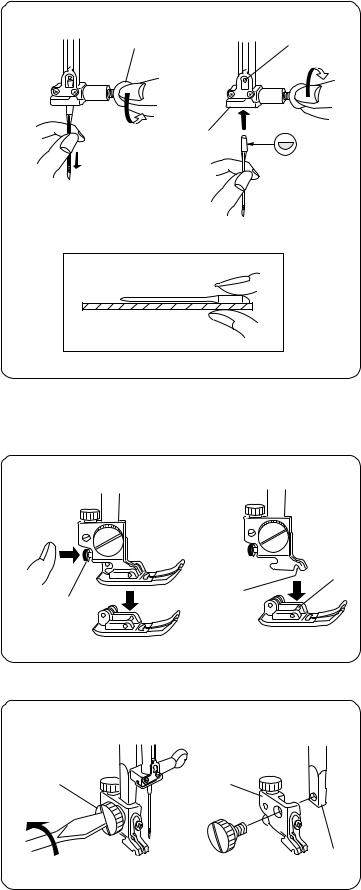
[1] |
[2] |
1 |
2 |
3
[3] |
[1] |
[2] |
3
2
1
[1] |
[2] |
1 |
2 |
3
14
Changing Needles
[1]Raise the needle by pressing the Up/down needle position key and lower the presser foot.
Turn off the power switch.
Loosen the needle clamp screw by turning it counterclockwise.
Remove the needle from the clamp.
[2]Insert the new needle into the needle clamp with the flat side to the rear.
When inserting the needle into the clamp, push it up as far as it will go. Tighten the clamp screw firmly by turning it clockwise.
[3]To check for a good needle, put the flat side of the needle onto something flat (the needle plate, glass etc.).
The gap between the needle and the flat surface should be consistent. Never use a bent or blunt needle.
1 Needle clamp screw
2 Pin
3 Needle clamp
To Attach and Remove the Presser Foot
[1]Press the red button on the back of the foot holder. The presser foot will drop off.
[2]Place the selected presser foot so the pin on the foot lies just under the groove of the foot holder.
Lower the presser bar to lock the foot in place.
1 Red button
2 Groove
3 Pin
To Remove and Attach the Foot Holder
[1]To Remove:
Remove the thumb screw by turning the screw counterclockwise with the screwdriver.
[2]To Attach:
Match the hole in the foot holder with the threaded hole in the presser bar.
Fit the thumb screw into the hole. Tighten the screw by turning it clockwise.
1 Thumb screw
2 Foot holder
3 Presser bar
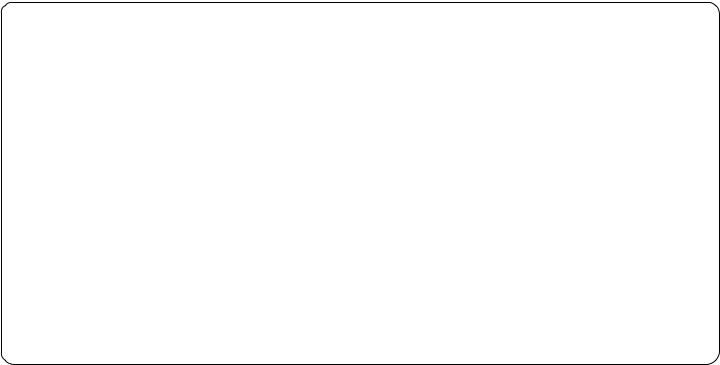
Selecting Needle and Thread
|
FABRICS |
THREADS |
NEEDLE SIZE |
|
|
|
|
|
Crepe de Chine, |
Fine Silk |
|
|
Voile, Lawn, |
Fine Cotton |
|
LIGHT WEIGHT |
Organdy, |
Fine Synthetic |
9 or 11 |
|
Georgette,Tricot |
Fine Cotton-covered Polyester |
|
|
|
|
|
|
Linens, Cotton, |
50 Silk |
|
|
Pique, Serge, |
50 to 80 Cotton |
|
MEDIUM WEIGHT |
Double Knits, |
50 to 60 Synthetic |
11 or 14 |
|
Percale |
Cotton-covered Polyester |
|
|
|
|
|
|
Denim, tweed, |
50 Silk |
|
|
Gabardine, Coating, |
40 to 50 Cotton |
|
HEAVY WEIGHT |
Drapery, and |
40 to 50 Synthetic |
14 or 16 |
|
Upholstery Fabric |
Cotton-covered Polyester |
|
|
|
|
|
NOTE:
*In general, fine threads and needles are used for sewing fine fabrics, and thicker threads and needles are used for sewing heavy fabrics.
Always test thread and needle size on a small piece of fabric which will be used for actual sewing.
*Use the same thread for needle and bobbin.
*When sewing stretch, very fine fabrics and synthetics, use a blue tipped needle. The blue tipped needle effectively prevents skipped stitches.
15
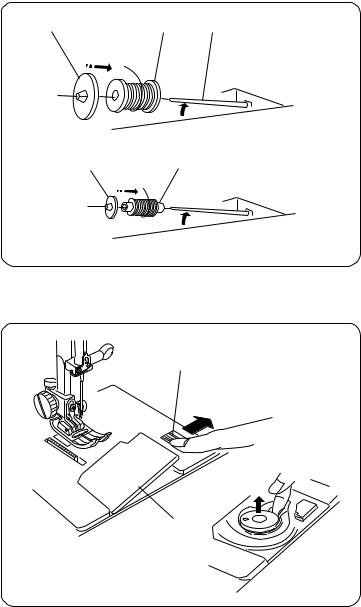
Winding the Bobbin
3 |
2 |
1 |
|
|
|
• Set the spool |
|
|
|
Lift up the spool pin and place the spool of thread on it |
|
|
|
with the thread coming off the spool as shown. |
|
|
|
Press the large spool holder firmly against the spool of |
|
|
|
thread. |
|
|
|
* The small spool holder is used with a small or narrow |
|
4 |
5 |
spool of thread. |
|
|
|
1 |
Spool pin |
|
|
2 |
Ordinary spool |
|
|
3 |
Large spool holder |
|
|
4 |
Small spool holder |
|
|
5 |
Small spool |
|
|
• Removing the bobbin |
|
|
1 |
Gently slide the hook cover plate release button to the |
|
|
right and remove the cover plate. |
||
|
|
||
|
|
Lift out the bobbin. |
|
|
|
1 |
Hook cover plate release button |
|
|
2 |
Hook cover plate |
2
16
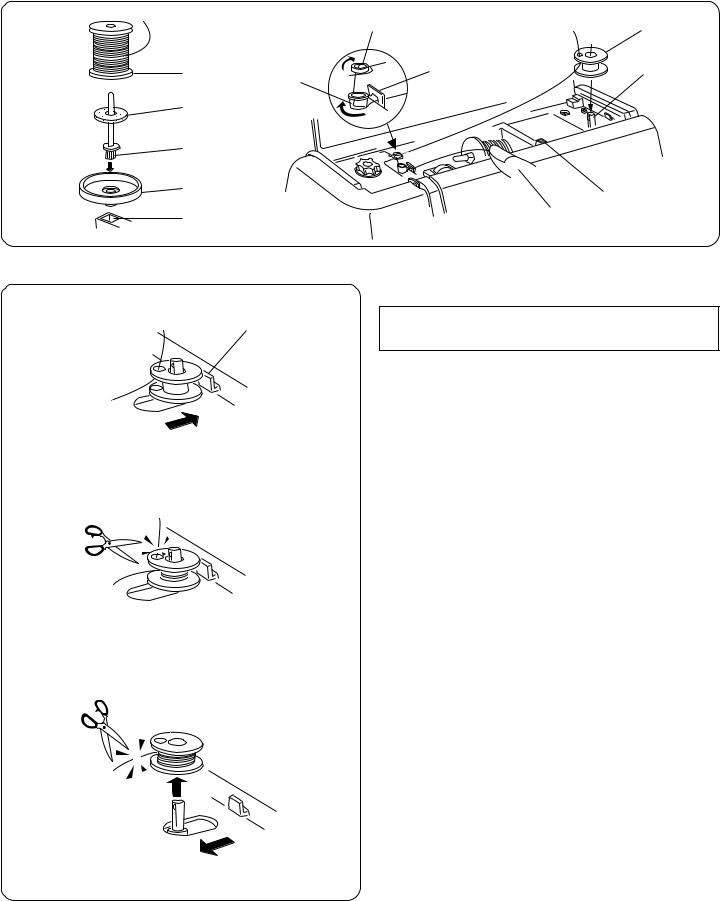
|
[4]“C” |
|
[5] |
3 |
[2] |
“A” |
1 |
|
|||
|
[3] |
|
|
5 |
“B” |
|
|
|
|
|
|
4 |
|
|
|
7 |
|
|
6 |
|
|
|
|
6 |
|
|
[1] |
[6] |
|
• Winding the bobbin |
|||
2 |
For the bobbin winding, set the speed control lever at |
||||
|
|||||
|
the medium to high speed position. |
||||
|
|
||||
|
|
[1] |
Hold the end of thread. |
||
|
|
[2] |
Guide the thread through the thread guide “A”. |
||
|
|
[3] |
Thread the thread guide “B”. |
||
|
|
[4] |
Thread the thread guide “C”. |
||
|
|
[5] |
Thread through the hole in the bobbin from the |
||
|
|
|
inside to the outside. |
||
[7] |
|
|
1 Bobbin winder spindle |
||
|
[6] |
Put the bobbin on the bobbin winder spindle, and |
|||
|
|
||||
|
|
|
push it to the right. |
||
|
|
|
2 Bobbin winder stopper |
||
|
|
[7] |
Hold the free end of the thread in your hand and |
||
|
|
|
depress the foot control. |
||
|
|
|
Stop the machine when it has made a few turns, |
||
|
|
|
and cut the thread close to the hole in the bobbin. |
||
|
|
|
Depress the foot control again. |
||
|
|
|
When the bobbin is fully wound, it will stop |
||
|
|
|
automatiaclly. |
||
, |
|
, |
Return the bobbin winder to its original position by |
||
|
|
|
moving the spindle to the left, and cut the thread as |
||
|
|
|
shown. |
||
|
|
* |
The machine will not sew until the spindle is in the |
||
|
|
|
left position. |
||
|
|
* |
You can also use the additional spool pin for the |
||
|
|
|
bobbin winding as shown. |
||
|
|
|
3 Spool |
||
|
|
|
4 |
Additional spool pin |
|
|
|
|
5 |
Felt |
|
|
|
|
6 |
Additional spool pin hole |
|
|
|
|
7 Spool base |
||
17
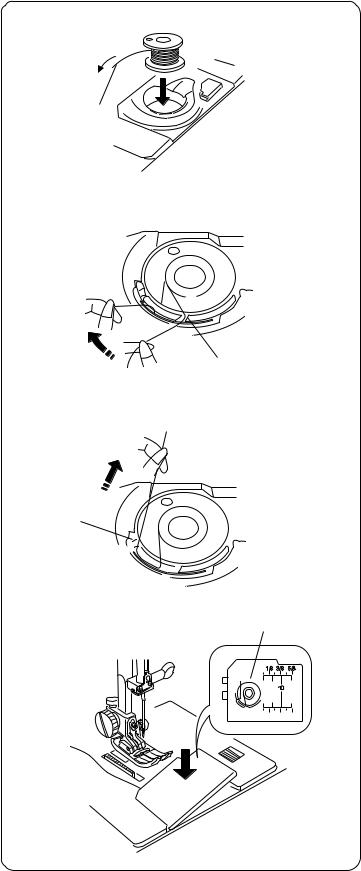
[1] |
• Inserting the bobbin |
|
[1] Place the bobbin in the bobbin holder with the thread |
||
|
||
|
running off counterclockwise. |
|
|
1 End of thread |
1
[2] |
[2] Guide the thread into the notchA on the front side |
|
|
of |
the bobbin holder. |
|
2 |
Notch A |
|
A |
|
2
[3] |
[3] Continue to draw the thread lightly. The thread slips |
|
|
into notch |
. |
|
Pull out about 15 cm (6”) of thread. |
|
|
3 Notch |
|
3
B 
4
[4]
[4]Attach the hook cover plate.
Check the threading by referring to the chart shown on the hook cover plate.
4 Threading chart
18
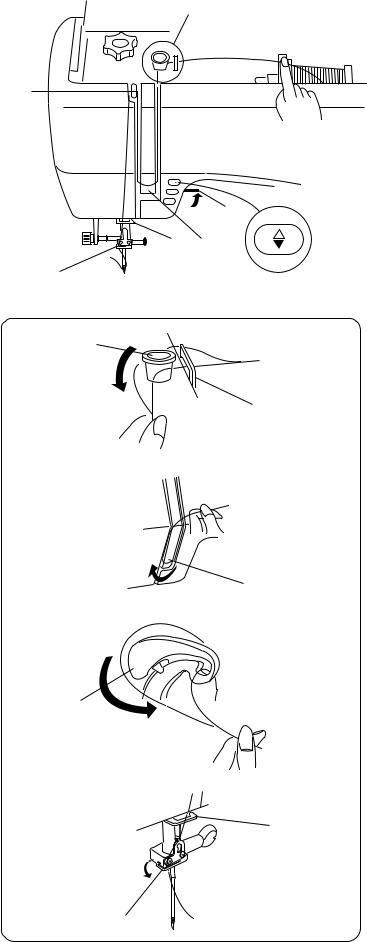
[3]
[5]
[1] 4
“B”
[2]
[3]
6
[4] [5]
8
[1]
1
[4] [2]
2
3 “A”
5
7 “D”
Threading the Machine
•Threading the machine
*Raise the presser foot lever.
*Turn the power switch “ON”, press the needle Up/down button twice to raise the needle, then turn the power switch “OFF”.
1 Presser bar lifter
2 Needle Up/down button
[1]Raise the presser foot lifter.
Draw the thread from the spool and thread around the upper thread guide “A” and “B”.
3 Thread guide “A”.
4 Thread guide “B”
[2]Then, down around the check spring holder. 5 Thread guide plate
[3]Turn the handwheel toward you to raise the thread take-up lever.
Firmly draw the thread from right to left over the take-up lever and down into the take-up lever eye. 6 Thread take-up lever
[4]Then, down through the lower thread guide. 7 Thread guide “D”
[5]Slide the thread behind the needle bar thread guide on the left.
8 Needle bar thread guide
* Use the automatic needle threader (see page 20).
19
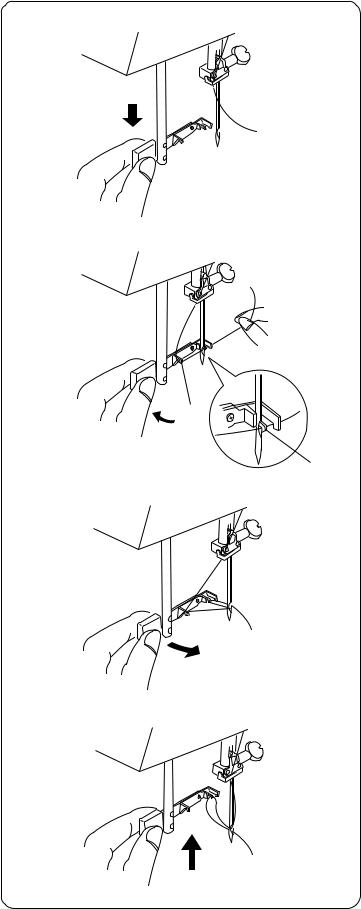
• Needle threader
[1] |
[1] Raise the needle to its highest position. Pull down the |
|
|
|
needle threader knob as far as it will go. |
[2] |
[2] Push the knob in the direction of the arrow in the |
|
|
illustration, inserting hook q into the needle eye. |
|
|
Lead the thread around guide w and under the hook. |
|
|
1 |
Hook |
|
2 |
Guide |
|
2 |
|
1 |
[3] |
[3] Holding on to the thread firmly with your right hand, |
|
pull the needle threader knob in the direction of the |
|
arrow in the illustration, and then upwards to pull the |
|
thread through the eye of the needle. |
[4] |
[4] Pull the thread through the needle eye. |
|
The needle threader can be used with a #11 to #16 |
|
needle or #11 Blue tip needle. |
|
Thread size 50 to 100 should work well. |
20
